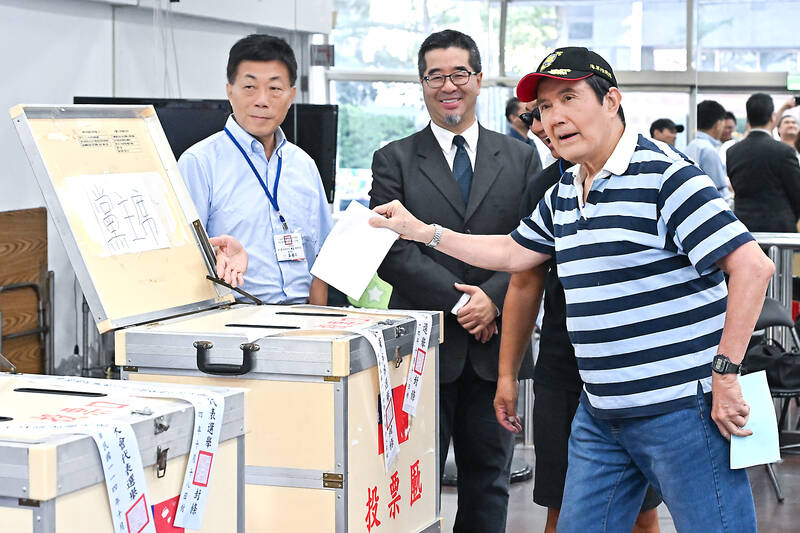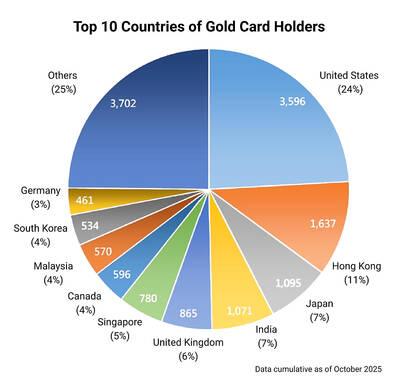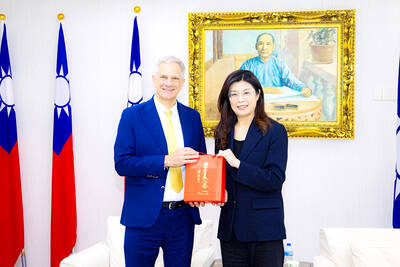The election of Cheng Li-wun (鄭麗文) as chair of the Chinese Nationalist Party (KMT) marked a triumphant return of pride in the “Chinese” in the party name. Cheng wants Taiwanese to be proud to call themselves Chinese again.
The unambiguous winner was a return to the KMT ideology that formed in the early 2000s under then chairman Lien Chan (連戰) and president Ma Ying-jeou (馬英九) put into practice as far as he could, until ultimately thwarted by hundreds of thousands of protestors thronging the streets in what became known as the Sunflower movement in 2014.
Cheng is an unambiguous Chinese ethnonationalist, proudly Chinese, and seeks the ultimate dream of annexation into China. The plan is to reach a peaceful agreement with the Chinese Communist Party (CCP) to coexist in some form, reduce military spending to reduce tensions, harmonize and integrate both sides into one Chinese cultural and economic sphere, then ultimately restore the glory of the Chinese nation by reunifying and rectifying the perceived 100 years of humiliation to reach the common dream of all Chinese people in restoring Chinese civilization to its rightful place on the world stage.

Photo: TT file photo
Of course, any deal for her would come with promises of significant autonomy so “Taiwanese compatriot,” as the CPP calls Taiwanese, could maintain their unique system and way of life within the greater Chinese nation. As the Tibetans, the Uighurs, the Mongolians and Hong Kongers will tell you, life in a Chinese autonomous region is a tribute to the wise and glorious leadership of the CCP, whose love of the people has brought peace and prosperity and strengthened local culture and traditions. If they do not say that, they could go to jail, or worse.
MA’S SOFT EDGES
Ma campaigned publicly with softer edges, including promises to raise defense spending and protect the Republic of China (ROC). In several interviews, including just prior to the last presidential election in an interview with media outlet DW, he has been clear that he had been laying the groundwork for reunification.

Photo: Chen Chih-chu, Taipei Times
Cheng is Ma with no soft edges and no apologies. All six of the candidates for chair were ideologically within this ideological framework to varying degrees, so no matter who won, the party was going to return to these older ideological roots.
After losing three presidential races in a row to the Democratic Progressive Party (DPP), which campaigned on protecting Taiwanese sovereignty, culture and identity, there was considerable talk and some attempts to move the KMT closer to the mainstream of public opinion, which had shifted towards the DPP on these issues in the wake of the Ma era and the Sunflower movement.
Some considered dropping the “Chinese” from the party name, and others went so far as to suggest renaming the party to “Taiwanese Nationalist Party.”
In 2020, the party elected the youthful moderate Johnny Chiang (江啟臣) in a byelection for party chair. He attempted to get the party to drop support for the so-called “1992 consensus,” which posits that there is only one China and that includes the province of Taiwan, but the KMT softens by adding “both sides with their own interpretation” of what “China” means — an addition the CCP has never accepted, insisting that China is only the People’s Republic of China (PRC), and not the ROC.
Chiang failed after pushback from the KMT membership. However, with an eye on electability, the party continued to try to tailor its message to sound more mainstream.
Mindful of Chiang’s failure, outgoing Chairman Eric Chu (朱立倫) tried to spin the “1992 consensus” as a “non-consensus consensus” to American audiences, while praising it to Chinese audiences. His “all things to all people” approach kept the party together, but satisfied no one.
After years of voter distrust in this ideology and the KMT’s intentions, why is the party now returning to this ideology with such fervor?
BACK TO BASICS
Most importantly, because this is what the KMT is. They revere Chinese civilization and identify with it ethnically and culturally.
The KMT was formed out of movements to reform Chinese civilization to bring it into the modern world and restore it to glory. Being cut off from the “motherland” is considered a painful aberration, and as long as the KMT’s reforms can be maintained in Taiwan, they would welcome “reunification,” as long as the “mainland” shows “sincerity and goodwill.”
They hate and fear DPP moves to put Taiwanese history, culture, identity and sovereignty on center stage. They feel this is a direct attack on their very sense of who and what they are, rendering their identity “foreign” or even the “enemy.”
To KMT party members, Cheng’s unapologetically proud and defiant defense of their identity must have felt liberating after years of waffling in the name of electability.
They also believe the pendulum is swinging back in their direction.
Last year, voters restored their party’s status as the biggest in the legislature, and with their allies in the Taiwan People’s Party (TPP), they voted along ideological lines to significantly hamper the DPP administration’s efforts to double down on defending against the CCP and counter their threats.
Pro-Taiwan protestors arose in the Bluebird Movement and failing to convince the KMT to back down, they launched recall campaigns against KMT lawmakers. The recalls failed miserably, with some receiving more votes defending them than they received when elected — which many in the party interpreted as support for the positions their lawmakers took
The DPP has also lost its lock on young voters, and there are signs that, especially those under 25 who are on Chinese-owned social media apps like TikTok, are more pro-China. Some who used to be fiercely pro-Taiwan, like TPP Chairman Huang Kuo-chang (黃國昌), influencer Holger Chen (陳之漢 aka 館長) and even Cheng herself, have defected to their side.
Though most polls showing voter support indicate the DPP is still larger, in Formosa polling the KMT has pulled ahead in being viewed more positively.
There is a sense of fatigue with the DPP after nearly 10 years in power, and democracies typically throw out ruling parties eventually. Problems continue to fester, housing prices are still sky high, incomes low and dreams of having a home and family out of reach for many.
TINY MINORITY
There are good reasons to believe the KMT membership may have overestimated the appeal of their ideology and how far the pendulum can swing.
Only 65,122 people voted for Cheng. There are roughly 330,000 KMT party members, and only 39 percent came out to vote in the chair election.
KMT party members are a tiny minority, and even many KMT voters find their ideology extreme. The percentage of the population identifying as “Chinese only” is in the low single digits, and support for annexation into China not much higher.
The big jump in legislative seats last year disguises that they actually won a lower percentage of the vote than in 2020, and only gained seats due to better strategic get-out-the-vote efforts in key districts.
They forget that the KMT’s efforts to launch recalls against DPP lawmakers all failed to even get off the ground.
They also fail to recognize that voters only rallied to their lawmakers after the DPP officially backed the recall campaigns against them, turning the KMT’s previously largely untrue claims that the DPP was trying to overturn last year’s elections into a legitimate fact. Polling consistently showed some recalls would likely have succeeded until the DPP got involved, so the results were more a rejection of the DPP and efforts to overturn a democratic election than they were any show of support for the KMT.
The KMT membership is correct that the current circumstances are more favorable to the party than they have been in a long time, but they are taking a risk that Cheng’s ideology may drive more people away from the party than she attracts.
Donovan’s Deep Dives is a regular column by Courtney Donovan Smith (石東文) who writes in-depth analysis on everything about Taiwan’s political scene and geopolitics. Donovan is also the central Taiwan correspondent at ICRT FM100 Radio News, co-publisher of Compass Magazine, co-founder Taiwan Report (report.tw) and former chair of the Taichung American Chamber of Commerce. Follow him on X: @donovan_smith.

Seven hundred job applications. One interview. Marco Mascaro arrived in Taiwan last year with a PhD in engineering physics and years of experience at a European research center. He thought his Gold Card would guarantee him a foothold in Taiwan’s job market. “It’s marketed as if Taiwan really needs you,” the 33-year-old Italian says. “The reality is that companies here don’t really need us.” The Employment Gold Card was designed to fix Taiwan’s labor shortage by offering foreign professionals a combined resident visa and open work permit valid for three years. But for many, like Mascaro, the welcome mat ends at the door. A

Last week gave us the droll little comedy of People’s Republic of China’s (PRC) consul general in Osaka posting a threat on X in response to Japanese Prime Minister Sanae Takaichi saying to the Diet that a Chinese attack on Taiwan may be an “existential threat” to Japan. That would allow Japanese Self Defence Forces to respond militarily. The PRC representative then said that if a “filthy neck sticks itself in uninvited, we will cut it off without a moment’s hesitation. Are you prepared for that?” This was widely, and probably deliberately, construed as a threat to behead Takaichi, though it

If China attacks, will Taiwanese be willing to fight? Analysts of certain types obsess over questions like this, especially military analysts and those with an ax to grind as to whether Taiwan is worth defending, or should be cut loose to appease Beijing. Fellow columnist Michael Turton in “Notes from Central Taiwan: Willing to fight for the homeland” (Nov. 6, page 12) provides a superb analysis of this topic, how it is used and manipulated to political ends and what the underlying data shows. The problem is that most analysis is centered around polling data, which as Turton observes, “many of these

Since Cheng Li-wun (鄭麗文) was elected Chinese Nationalist Party (KMT) chair on Oct. 18, she has become a polarizing figure. Her supporters see her as a firebrand critic of the ruling Democratic Progressive Party (DPP), while others, including some in her own party, have charged that she is Chinese President Xi Jinping’s (習近平) preferred candidate and that her election was possibly supported by the Chinese Communist Party’s (CPP) unit for political warfare and international influence, the “united front.” Indeed, Xi quickly congratulated Cheng upon her election. The 55-year-old former lawmaker and ex-talk show host, who was sworn in on Nov.